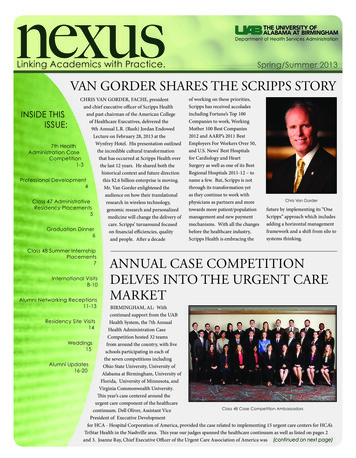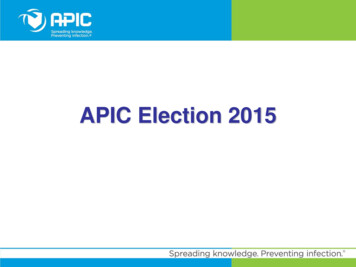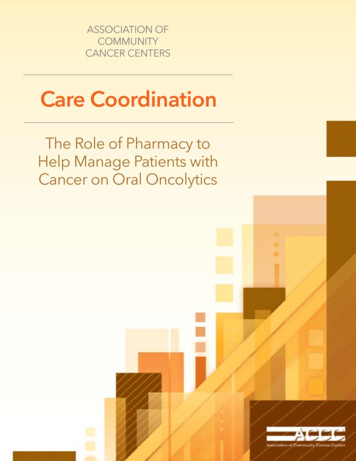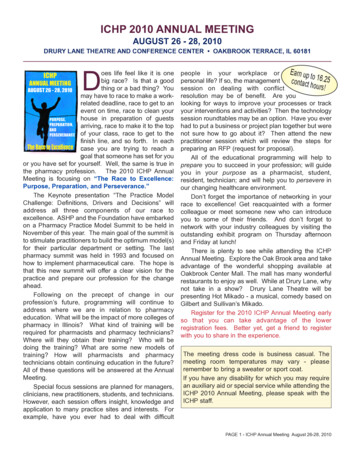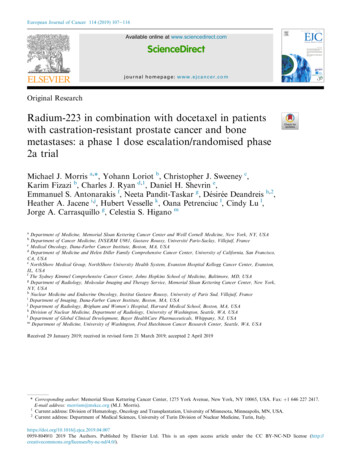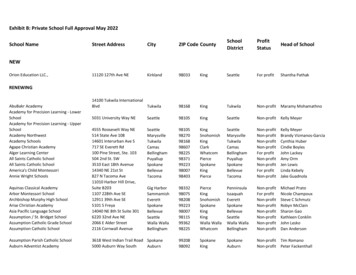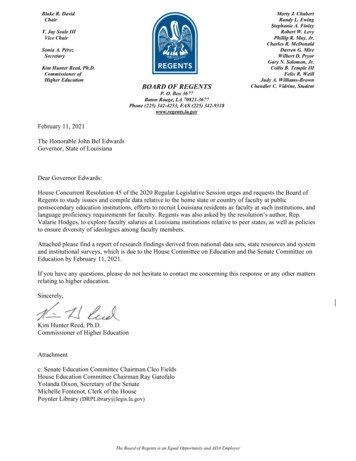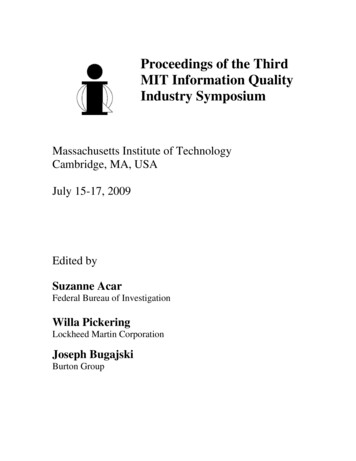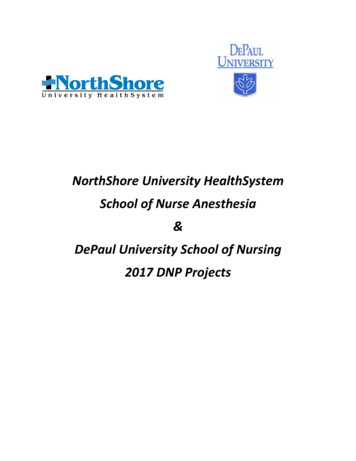
Transcription
NorthShore University HealthSystemSchool of Nurse Anesthesia&DePaul University School of Nursing2017 DNP Projects
CLASS OF 2017 DNP PROJECTS1. STEPHEN REIMERS, BSN, RNEvaluation of Entry-Level Nurse Anesthesia Educational Programs: A National SurveyCommittee: Karen Kapanke CRNA, DNP-Chair; Pamela Schwartz CRNA, DNP .42. ANDREW GAUSE, BSN, RN AND ZAIN REHMAN, BSN, RNEvaluation of a Video-Based Left Ventricular Assist Device Education Program forCertified Registered Nurse AnesthetistsCommittee: Karen Kapanke CRNA, DNP-Chair; Julia Feczko CRNA, DNP 53. AMBER MUHLHAN BSN, RN & CLAR SARANGAY BSN, RNCurrent Use of Muscle Relaxants and Laryngeal Mask Airways: A Survey of Anesthesia Providers’Knowledge and Beliefs for Best PracticeCommittee: Julia Feczko CRNA, DNP –Chair; Pamela Schwartz CRNA, DNP 64. LAURA MAJEWSKI BSN, RN & PAULINE TSELONIS BSN, RNTask Management Training for Recognition, Prioritization and Decision Making for the SRNACommittee: Julia Feczko CRNA, DNP –Chair and Susan Krawczyk CRNA, DNP .75. RACHEL KOZLOWSKI BSN, RN & JENN KUDIRKA BSN, RNVideo Simulation as an Educational Strategy to Increase Knowledge and Perceived Knowledge inNovice Nurse Anesthesia TraineesCommittee: Pamela Schwartz CRNA, DNP-Chair; Julia Feczko CRNA, DNP;Karen Kapanke CRNA, DNP .86. KIM HOMA BSN, RN & JACKIE KUHN BSN, RNCRNA’s Knowledge and Attitudes Regarding Acupressure as an Adjunct to Postoperative Nauseaand Vomiting PreventionCommittee: Pamela Schwartz CRNA, DNP-Chair, Young-Me Lee RN, PhD 92
CLASS OF 2017 DNP PROJECTS7. RACHEL FERRAL BSN, RN & ANGELA MEYER BSN, RNA Needs Assessment for Development of an Interpreter Services Educational Tool for CRNAsCommittee: Young-Me Lee RN, PhD-Chair; Bernadette Roche CRNA, EdD .108. KELLY LANNERT BSN, RN & DULCIE SCHIPPA BSN, RNIntra-operative Awareness with Recall under General AnesthesiaCommittee: Bernadette Roche CRNA, EdD-Chair; Karen Kapanke CRNA, DNP; Joseph TarimanPhD, ANP, BC .119. AMBER LINDSAY BSN, RN & ELISA RUE BSN, RNA Standardized Electronic Handover Report for Anesthesia ProvidersCommittee: Julia Feczko CRNA, DNP –Chair; Mark Deshur M.D 1210. ALISON KARMANIAN BSN, RNIntraoperative Blood Pressure and Effect of Volatile Anesthetic in Brain Dead Organ DonorsCommittee: Pamela Schwartz CRNA, DNP-Chair; Michael Harmon BSN, RN, CPTC;Jeff Matson CRNA, MS 1311. ALYSE VORONOV BSN, RN & NICOLE ZEPPO BSN, RNPediatric Emergence Delirium Assessment and Documentation: Current Practice and PerceivedBarriersCommittee: Susan Krawczyk CRNA, DNP-Chair; Mary Ann Zervakis–Brent CRNA, DNP; PolinaVoronov M.D .143
CLASS OF 2017 DNP PROJECTSEVALUATION OF ENTRY-LEVELNURSE ANESTHESIA EDUCATIONALPROGRAMS: A NATIONAL SURVESTEPHEN REIMERS, BSN, RNBACKGROUNDThe requirement for all nurse anesthesia educational programs to transition to offering practicedoctorates by January 1, 2022 signals a turning point in nurse anesthesia education.OBJECTIVESThe primary goals of this project were to determine the most significant barriers nurse anesthesiaprograms faced when transitioning offering a practice doctorate and to assess how the transitionaffected various program functions and outcomes.METHODSAn electronic survey was sent to the program administrators of all nurse anesthesia educationalprograms regarding potential barriers about transitioning to a practice doctorate, as well as programdemographic, program function, and program outcome questions.RESULTSThe highest rated barrier to transitioning to a practice doctorate was “managing student DNP projects”.Nearly every program administrator reported an increase in faculty workload after transitioning to adoctorate program. Half of the DNP programs reported a decrease in the first-time NationalCertification Exam pass rate since transitioning to a practice doctorate.CONCLUSIONSProfessional groups could greatly assist programs in the transition to offering practice doctorates byproviding greater support for managing student DNP projects. Programs that transition to offeringpractice doctorates should develop strategies to prevent a decline in first-time pass rates of the NationalCertification Exam4
CLASS OF 2017 DNP PROJECTSEVALUATION OF A VIDEOBASED LEFT VENTRICULARASSIST DEVICE EDUCATIONPROGRAM FOR CERTIFIEDREGISTERED NURSEANESTHETISTANDREW GAUSE, BSN, RNZAIN REHMAN, BSN, RNBACKGROUNDVideo-based educational programs have been proven as a more effective means of instruction thantraditional lecture and paper-based formats. Therefore, a video-based left ventricular assist device(LVAD) program was developed to address an identified knowledge gap for the NorthShore UniversityHealthSystem (NSUHS) certified registered nurse anesthetists (CRNA) and student registered nurseanesthetists (SRNA).OBJECTIVESThe purpose of this quality improvement project (QIP) was to pilot a newly developed educational videointervention and evaluate the CRNAs’ and SRNAs’ pre- and post-intervention knowledge difference ofthe LVAD and the LVAD patient population.METHODSThe sample consisted of 13 CRNAs and SRNAs from NSUHS and the NSUHS School of Nurse Anesthesia.Pre- and post-tests were used and uploaded to Google Forms to maintain anonymity and SPSS was usedfor data analysis.RESULTSPre-test scores were found to be less than adequate (M 5.46, SD 1.71). Post-test scores after theeducational video intervention did improve (M 6.46, SD 1.90), however, the results were statisticallynot significant (M 1.00, SD 1.87, -0.13 to 2.13 CI 95%, p 0.078). The Kuder-Richardson-20 (KR20)reliability coefficient for post-test scores was 0.518, which demonstrated adequate internal consistencyfor the post-test.CONCLUSIONSThe results demonstrated that the LVAD educational video interventions did improve post-test scores,when compared to pre-test scores. Although the results were statistically not significant and furtherlarge-sample studies are needed, this educational video intervention can be a useful tool to bridge theNSUHS CRNAs and SRNAs knowledge gap of LVADs and the LVAD patient population.5
CLASS OF 2017 DNP PROJECTSCURRENT USE OFMUSCLE RELAXANTS ANDLARYNGEAL MASKAIRWAYS: A SURVEY OFANESTHESIA PROVIDERS’KNOWLEDGE ANDBELIEFS FOR BESTPRACTICEAMBER MUHLHAN BSN, RNCLAR SARANGAY BSN, RNBACKGROUNDCurrent clinical studies have shown that muscle relaxant use has beneficial effects with laryngeal maskairways; however, knowledge and beliefs differ regarding this practice amongst anesthesia providers.OBJECTIVESThe purpose of this study was to evaluate the knowledge and beliefs of anesthesia providers aboutmuscle relaxant use with laryngeal mask airways before and after reviewing an evidence-basededucational module.METHODA descriptive online survey research design was utilized to determine Illinois Association of NurseAnesthetist members’ knowledge and beliefs regarding muscle relaxant use with laryngeal maskairways.RESULTSAt pre-test, the study participants had deficient knowledge and negative beliefs regarding the use ofmuscle relaxants with laryngeal mask airways. After reviewing an evidence-based educational module,the paired t test showed that the study participants demonstrated a statistically significant increase inknowledge and a positive belief towards incorporating muscle relaxants with laryngeal mask airwaysinto their practice (n 72; t -3.856; df 71; p 0.001). The evidence-based educational module had amedium size effect towards the change in the mean scores for knowledge and beliefs (Cohen's d 0.45).CONCLUSIONSThis study found that study participants have a lack of knowledge and negative beliefs towards musclerelaxant use with laryngeal mask airways prior to an educational intervention. An evidence-basededucational module proved to be an effective way to educate providers and alter their negative beliefsrelated to best practice. There is a need for additional studies that would support a position statementfor a standard of practice and policy making for muscle relaxant use with laryngeal mask airways incontemporary anesthesia practice.6
CLASS OF 2017 DNP PROJECTSTASK MANAGEMENTTRAINING FORRECOGNITION,PRIORITIZATION ANDDECISION MAKING FORTHE SRNALAURA MAJEWSKI BSN, RNPAULINE TSELONIS BSN, RNBACKGROUNDNon-technical skills have been identified to be the key determinant of successful anesthesia particularlyduring crisis management. Task-related non-technical skills, such as recognition, prioritization, anddecision-making are essential for safe anesthesia.Objectives: The purpose is to improve three non-technical skills (recognition, prioritization, and decisionmaking) in SRNAs new to the clinical setting with the use of an instructional video demonstrating theappropriate management of an airway obstruction during monitored anesthesia care (MAC).METHODA quasi-experimental pre-test and post-test and critical action survey design were used to investigatethe effect of a pre-recorded instructional video. A convenience sample of student volunteers in theirsecond or third year of graduate school as SRNAs at NorthShore University HealthSystem School ofNurse Anesthesia.RESULTSWilcoxon Signed Ranks Test demonstrated statistically significant differences in the participants' level ofcomfort in recognition and prioritization, pre and post-instructional video [Z -3.507; p .000 (2-tailed).]A positive correlation was demonstrated between comfort, with use of the post-video survey, andconfidence, with use of the Critical Action Survey, by using Spearman’s r. Results demonstrated asignificant positive relationship, where increases in comfort with non-technical tasks was associatedwith increased critical action mean scores for confidence both in the pre-test mean score of comfort(r 0.843; p 0.001) and post-test mean score for comfort (r 0.931; p 0.001) characterized by verystrong positive correlations (correlation being significant at the 0.01 level).CONCLUSIONSWe demonstrated improved comfort and confidence of SRNAs in recognition, prioritization and decisionmaking with improved mean scores in all variables. This provides preliminary evidence on the benefits ofinstructional video on task-management education to SRNAs. Further studies can expand on thisresearch by utilizing videos to enhance other non-technical skills.7
CLASS OF 2017 DNP PROJECTSVIDEO SIMULATION ASAN EDUCATIONALSTRATEGY TO INCREASEKNOWLEDGE ANDPERCEIVED KNOWLEDGEIN NOVICE NURSEANESTHESIA TRAINEESRACHEL KOZLOWSKI BSN, RNJENN KUDIRKA BSN, RNBACKGROUNDVideo simulation is gaining popularity as an alternative method of teaching and can play an importantrole in nurse anesthesia education.Objectives: The purpose of this study is to analyze the effects of an educational video simulation onacquisition of knowledge and perceived knowledge of anesthesia induction in novice nurse anesthesiatrainees (NATs).METHODSA single group pre-test post-test design was used to compare knowledge and perceived knowledge onstandard and rapid sequencing induction of anesthesia. Pre test scores on knowledge and perceivedknowledge were obtained and followed by a viewing of pre-recorded video simulation on standard andrapid sequence of anesthesia induction. Post test scores were obtained immediately after viewing thecomplete pre-recorded video simulation. The convenience sample included volunteers who were secondyear NATs at NorthShore University HealthSystem School of Nurse Anesthesia.RESULTSTwelve NATs participated in the single group pretest-posttest design. The Wilcoxon signed ranks testrevealed all statistically significant score differences in all five ordinal outcomes for perceived knowledgestandard induction (all p values or 0.05) and perceived knowledge rapid sequence induction (all pvalues or 0.05). The Wilcoxon signed ranks test and paired samples t test revealed statisticallysignificantly difference mean scores on NATs’ knowledge for both standard induction (Z -2.944; p 0.003) and rapid sequence induction of anesthesia (t 4.711; p 0.001), respectively.CONCLUSIONSViewing a video simulation on the sequence of standard and rapid sequence anesthesia inductionincreased both knowledge and perceived knowledge among novice NATs. This pilot study providespreliminary evidence that there is a role for video simulation education in the curriculum of nurseanesthesia programs.8
CLASS OF 2017 DNP PROJECTSCRNA’S KNOWLEDGE ANDATTITUDES REGARDINGACUPRESSURE AS ANADJUNCT TOPOSTOPERATIVE NAUSEAAND VOMITINGPREVENTIONKIM HOMA BSN, RNJACQUELINE KUHN BSN, RNBACKGROUNDPostoperative nausea and vomiting (PONV) continues to be a problem for patients despite multimodalpharmacologic treatments available. Although acupressure has demonstrated clinical usefulness, it isstill not widely used in Western anesthesia practice.OBJECTIVESTo assess current knowledge and attitudes among CRNAs and SRNAs regarding acupressure use forPONV treatment.METHODSA survey was distributed via email to members of the Illinois Association of Nurse Anesthetists (IANA) toassess their knowledge and attitudes regarding acupressure for PONV treatment.Results: A total of 109 out of 1200 members of the IANA completed the survey (9% survey responserate). Overall, participants had adequate knowledge and positive attitudes regarding acupressure forPONV management. Of the 14 knowledge and attitude questions on the survey, the items with lowestmean scores indicated deficits in the knowledge on effectiveness of acupressure for PONV treatment (M 2.81; SD .518), its impact on surgical outcomes (M 2.71; SD .628), and the enhancement ofcomfort for patients postoperatively (M 2.87; SD .511). Among sociodemographic variablesexamined, females scored higher in overall knowledge and attitudes for use of acupressure for PONV (p 0.12).CONCLUSIONSOverall, CRNAs have adequate knowledge and positive attitudes regarding use of acupressure for PONVmanagement, but lack knowledge on acupressure effects on patient comfort, efficacy of PONV relief andpost-surgical outcomes. Areas of identified deficits were used to create an educational handout forCRNAs to further increase their knowledge and positive attitudes towards use of acupressure for PONV.Increased education can potentially lead to standardized implementation of acupressure in anesthesiapractice and decreased incidence of PONV in surgical patients.9
CLASS OF 2017 DNP PROJECTSA NEEDS ASSESSMENTFOR DEVELOPMENT OFAN INTERPRETERSERVICES EDUCATIONALTOOL FOR CRNASRACHEL FERRAL BSN, RNANGELA MEYER BSN, RNBACKGROUNDDespite evidence of provider misuse of interpreter services and the resultant adverse outcomes that can and haveoccurred, few studies have assessed or addressed the gaps in knowledge and attitudes of certified registered nurseanesthetists (CRNAs) towards interpreter service usage when providing care for and consenting limited Englishproficient (LEP) patients.OBJECTIVESThe purpose of this descriptive survey study was to identify CRNA knowledge and attitudes toward interpreterservice usage for LEP patients to guide the development of a competency educational tool for CRNAs.METHODSA descriptive, online survey research design was used. The Qualtrics online survey platform was used toadminister the survey to CRNAs who are members of the Illinois Association of Nurse Anesthetists (IANA) to assesstheir knowledge and attitudes toward interpreter service use.RESULTSA total of 92 CRNAs participated in this study. This study found a statistically significant positive linear relationshipbetween female gender and a higher mean score of knowledge using point bi-serial correlation analysis (p 0.001).Females tended to have greater knowledge regarding interpreter service use than males. All five questions in theknowledge questionnaire had mean scores indicative of knowledge deficit regarding appropriate interpreterservice use. The attitudes questionnaire had a mean of 15.28 (SD 3.31), indicating a positive trend in attitudestowards interpreter service use. Many study participants (62%; n 57) have not received continuing education oninterpreter services at their primary place of practice and most participants (65%; n 60) reported either notreceiving or not knowing how often continuing education on interpreter services is offered. These responsessupport a need for the development of a competency educational tool to be used as a continuing educationresource on interpreter service use among CRNAs for improved safety and quality of care of LEP patients.CONCLUSIONSImproving the knowledge of appropriate interpreter service use among CRNAs can lead to improved quality andsafety of patient care and improved health outcomes of those served by these anesthesia providers. Identifyingand addressing informational and attitudinal barriers are key to a consistent use of interpreter services.10
CLASS OF 2017 DNP PROJECTSINTRA-OPERATIVEAWARENESS WITHRECALL UNDER GENERALANESTHESIAKELLY LANNERT BSN, RNDULCIE SCHIPPA BSN, RNBACKGROUNDAnesthesia practitioners are familiar with awareness with recall (AWR) as a phenomenon, however,research has shown it is inadequately assessed, evaluated, and treated in patients receiving generalanesthesia leading to significant undesired sequela.OBJECTIVESThe purpose of this quality improvement project (QIP) was to attempt to improve the perceivedknowledge and comfort of anesthesia practitioners relative to the assessment, evaluation, andtreatment of patients with AWR, thus, closing the gap between knowledge and practice.METHODSThe sample consisted of 150 anesthesia practitioners from the Northshore University HealthSystem.Pre-and post-test Likert-type surveys were used and uploaded into Qualtrics to maintain anonymity andSPSS for analysis.RESULTSAt pre-test, the overall perceived knowledge, comfort and attitudes on AWR (M 2.59; SD 0.45) wassuboptimal for current practice. At post-test, the overall perceived knowledge, comfort and attitudes onAWR (M 3.41; SD .29) was optimal. A perceived knowledge subset analysis resulted (M 13.71; SD 2.61, respectively) and Cohen d statistics (d 1.466), Cronbach’s alpha coefficient was 0.72. A perceivedcomfort subset analysis resulted (M 3.71; SD 1.86, respectively) and Cohen d statistics (d 1.17),Cronbach’s alpha coefficient for this subscale was 0.85. Attitudes towards AWR had an inadequateCronbach's alpha coefficient value of less than 0.7. No subset analysis was performed.CONCLUSIONSThe results showed improved perceived knowledge and comfort of assessment, evaluation andtreatment of AWR. This is a useful indicator for communication and training needs in the initiation ofour educational program as a standard protocol in a local practice setting.11
CLASS OF 2017 DNP PROJECTSA STANDARDIZEDELECTRONICHANDOVER REPORTFOR ANESTHESIAPROVIDERSAMBER LINDSAY BSN, RNELISA RUE BSN, RNBACKGROUNDIntraoperative anesthesia handovers have remained unstandardized at many institutions.OBJECTIVESThe purpose of this study was to 1) develop an Anesthesia Handover Report (AHR) using an ExpertSampling Group; 2) evaluate the impact of the AHR on the perceived quality of handover amonganesthesia providers; and 3) assess the uptake of the AHR.METHODSIn Phase 1, an Expert Sampling Group of ten experienced anesthesia providers evaluated the preliminaryAHR for its accessibility, layout and content. In Phase 2, expert feedback was used to create the finalizedAHR and all 140 anesthesia providers at three study locations were invited to utilize and evaluate theAHR during intraoperative anesthesia handover, during Phase 3 the use of the AHR was queried.RESULTSFive anesthesia providers completed the Expert Sampling Group Questionnaire in Phase 1. Feedbackwas used to create the finalized AHR. During Phase 2, 21 anesthesia providers completed the 14question Anesthesia Handover Survey. The overall mean Likert score for handover conduct was 3.72 (SD.475, minimum 2, maximum 4), for teamwork was 3.76 (SD .432, minimum 3, maximum 4), andhandover quality was 3.64 (SD .611, minimum 1, maximum 4). Results of Phase 3 indicated the uptakedid not increase as expected over the six-week monitoring window, but rather peaked during week four.CONCLUSIONSUse of the AHR improved the perceived conduct, teamwork, and quality of intraoperative anesthesiahandovers. The use of the AHR did not improve over time.12
CLASS OF 2017 DNP PROJECTSINTRAOPERATIVE BLOOD PRESSUREAND EFFECT OF VOLATILEANESTHETIC IN BRAIN DEAD ORGANDONORSALISON KARMANIAN BSN, RNBACKGROUNDThere is a large disparity between the number of people waiting for organ transplants and the numberof organs available. Optimal hemodynamic management can influence transplant outcomes, thereforeevidence-based hemodynamic management should be practiced to maximize scarce donor organs.OBJECTIVESThe purpose of this study was to examine intraoperative blood pressures and administration of volatileanesthetics during brain dead organ donor procurements. Use of volatile anesthetics was examined todetermine how use and dose affected the ability to maintain mean arterial pressure (MAP) between 60to 90 mmHg.METHODSThis study was a retrospective chart review.RESULTSTwenty-eight cases were analyzed using the mean MAP calculated for each donor. Mean scores rangedfrom 61.04 to 99.34 mmHg with a mean of M 84.51 mmHg. Twenty-two donors (78.6%) receivedvolatile anesthetic gas, and six donors (21.4%) received no volatile anesthetic gas. Mean end-tidalconcentrations of volatile anesthetic gas in the 22 donors who received volatile anesthetic gas rangedfrom 0 to 1.25% with a mean end-tidal concentration of M 0.39%. Mean MAP in donors that did notreceive volatile anesthetic gas was M 78.49 mmHg (SD 9.78 mmHg). Mean MAP in donors thatreceived volatile anesthetic gas was M 86.16 mmHg (SD 7.02 mmHg). An independent samples t testperformed between these two groups demonstrated that the difference between mean MAPs of thetwo groups was statistically significant (t 2.182, p 0.038), but no statistically significant correlation wasfound between mean MAP and mean end-tidal volatile anesthetic gas (rs -0.184, p 0.414).CONCLUSIONSThis study demonstrated that intraoperative hypertension is more prevalent than intraoperativehypotension, and volatile anesthetic gas is often used at this medical center during organ procurementsat relatively low concentrations.13
CLASS OF 2017 DNP PROJECTSPEDIATRIC EMERGENCEDELIRIUM ASSESSMENTAND DOCUMENTATION:CURRENT PRACTICE ANDPERCEIVED BARRIERSALYSE VORONOV BSN, RNNICOLE ZEPPO BSN, RNBACKGROUNDCurrent literature addresses the complexity of identifying pediatric emergence delirium (PED), but doesnot address barriers to PED assessment and documentation. By identifying these barriers, furtherresearch can be conducted regarding prevention and treatment of PED.OBJECTIVESThis study aimed to: 1) describe the current PED assessment and documentation practices among postanesthesia care unit (PACU) registered nurses and anesthesia providers at UIHHSS; 2) describe theperceived barriers to PED assessment and documentation; and 2) develop an evidence basededucational program to aid in the implementation of a validated PED assessment tool.METHODSA descriptive, cross-sectional online survey design was used to survey a convenience sample of 133perioperative care providers consisting of anesthesia provides (anesthesiology attendings,anesthesiology residents, and certified registered nurse anesthetists) and PACU registered nurses atUIHHSS. Questions associated with perceived barriers to PED assessment and documentation practicewere answered using a 5-point Likert-type response scale with 1 strongly disagree, 2 disagree, 3 neutral, 4 agree, 5 strongly agree.RESULTSThe study received 40 responses during the data collection period for a response rate of 30%. Studyresults revealed current PED assessment and documentation practices at UIHHSS to be inconsistent andvaried. Of statistical significance (p 0.036) was the perceive barrier of “limited time” in the distributionof mean scores based on “how often do you care for pediatric patients.” Preferred learning methodsvaried, however a majority of participants (n 1) preferred a multimodal approach.CONCLUSIONSThe results of this study revealed the barriers to PED assessment and documentation at UIHHSS, as wellas the preferred learning methods of the participants. These results will help facilitate the creation of anevidence based, three-phase educational approach to change practice at UIHHSS.14
second or third year of graduate school as SRNAs at NorthShore University HealthSystem School of Nurse Anesthesia. RESULTS Wilcoxon Signed Ranks Test demonstrated statistically significant differences in the participants' level of comfort in recognition and prioritization, pre and post-instructional video [Z -3.507; p .000 (2-tailed).]
